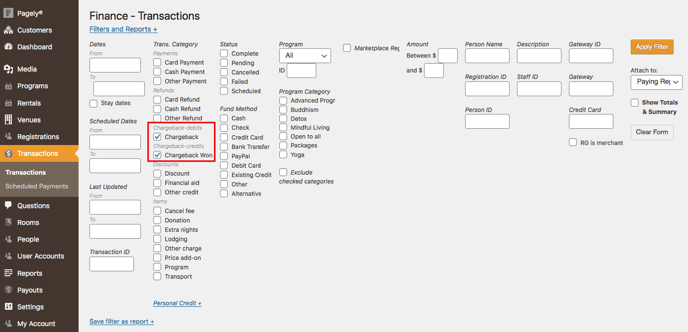How to recognize, handle and categorize chargebacks.
This information is applicable to centers that use Retreat Guru as their payment processor and have experienced a chargeback. However, much of the information presented will assist all centers, regardless of the processor - check with your card payment processor to learn more about their specific policies and procedures. If you would like more information on how to get ahead of chargebacks please check out Defense Against Chargebacks.
In this article we'll cover how to determine when to accept and dispute chargebacks, how to submit evidence and how to identify and use two new chargeback transaction categories.
- Chargeback Processes
- Chargebacks in Retreat Booking Guru
When to Accept
When you accept a chargeback the funds will be issued to the cardholder and you will still be charged a chargeback fee. Accepting a chargeback indicates you don't wish to take any further action, but it doesn't necessarily imply you agree with the cardholder's claim.
When it comes to fraudulent charges, accepting a chargeback is particularly common when a merchant receives a chargeback for an American Express® transaction; they are strong advocates for their card members. As a result merchants are usually at a disadvantage when the chargeback is related to fraud.
Merchants typically accept chargebacks if:
-
- The transaction amount is minor enough that it doesn’t justify the work of submitting evidence
-
- The transaction is known to be fraudulent
-
A refund is warranted and the chargeback can be accepted in lieu of issuing a manual refund
When to Dispute
Merchants typically dispute chargebacks if:
-
- They are confident the transaction was legitimate
- They have compelling evidence against the chargeback
- The disputed amount is large enough to justify the work of submitting evidence
- A refund has already been issued for the disputed transaction
How to Submit Evidence
To submit evidence, for payout clients using Retreat Guru as a payment processor reply to the chargeback notification email with your evidence. It is important to submit this before the deadline communicated to you in the notification, if the deadline is missed the dispute will be dismissed. For centers using a different payment processor, generally you can upload evidence in your customer space and submit directly with your processor.
Each chargeback is different, so the evidence you provide will vary depending on the reason for the chargeback and the information/documents you have available. We recommend keeping records of all transactions so you are prepared in the event that a chargeback happens. The more evidence you can provide the better. If you have meaningful evidence that you believe may prove legitimacy of a transaction, always include it. There is a limit of 4mb for total evidence you can provide, each item must be less than 1mb in file size. We recommend providing whichever pieces of relevant evidence you feel most confident in.
For security and privacy purposes, please do not provide items showing or containing full credit/debit card numbers, social security numbers, driver’s license numbers, or any other personally identifiable information or sensitive information as it pertains to you, your business or your customers. We recommend using your best judgment when choosing supportive evidence for your cases.
Some helpful items may include, but are not limited to:
-
- Screenshots of any signatures proving payments authorization from the customer
- Email correspondence between you and the customer
- Proof of delivery screenshots
- Your site's Terms of Service
- Social media screenshots (if the customer has posted pictures or checked in at your business)
- User's IP address
- Customer's username
- Service usage times, dates, etc.
Certain types of chargebacks involving fraud or merchandise/services not received require specific compelling evidence, as defined by card brands. These chargebacks are identified by their dispute reason. If you are unable to provide required evidence, your dispute will not be accepted by the card brand, and you will need to accept the case.
For chargebacks relating to fraud or merchant/services not received, you'll need to provide proof of at least one of the following pieces of evidence:
-
- Documentation to prove the customer is in possession of or using the merchandise
- A signed delivery form, or copy of customer ID as proof goods were picked up at your business location
- Delivery to the address associated with an AVS matched response
- Delivery and customer proof of employment at the delivery location
- Ticket was received or used
- The transaction was completed by an authorized signer associated with the cardholder
- A signed order form for a mail or phone transaction
- Digital goods downloaded from your website or app
- Previously undisputed transaction(s) for the same merchandise or service
- Previously undisputed recurring transaction history
Chargebacks in Retreat Booking Guru
We've integrated managing chargebacks into our software so you can keep all your transaction information in one place.
Chargeback Transaction
We've integrated chargebacks into our payment system. We know chargebacks aren't a fun topic but keeping a record of these transactions is an important part of running a retreat center. You may notice these new transaction categories in reports or on a registration.
For centers using Retreat Guru as their payment processor, you may see this automatically applied to a registration and the equivalent adjustment applied to your payout plus the chargeback fee.
For centers using another payment processor, you can use these transaction categories for record-keeping but they will need to be added manually.
When a chargeback is applied to a registration you may see Chargeback (open) as a new transaction on the registration and your transaction reporting. This transaction category is a deduction from the guest's bill.
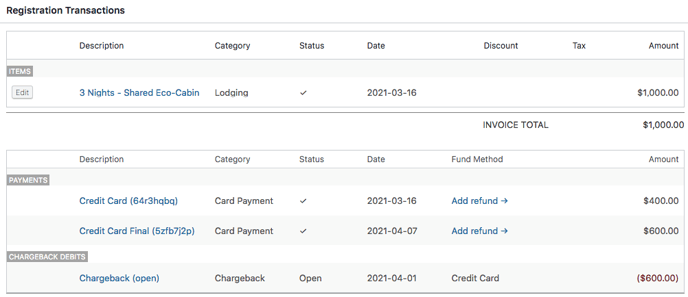
To manually add a chargeback to a registration, open a registration and choose an option to add a payment.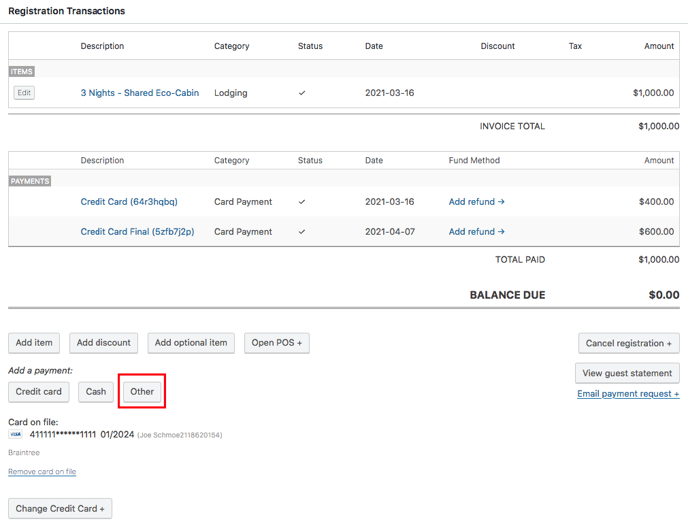
You can now choose Chargeback from the transaction category drop-down menu.
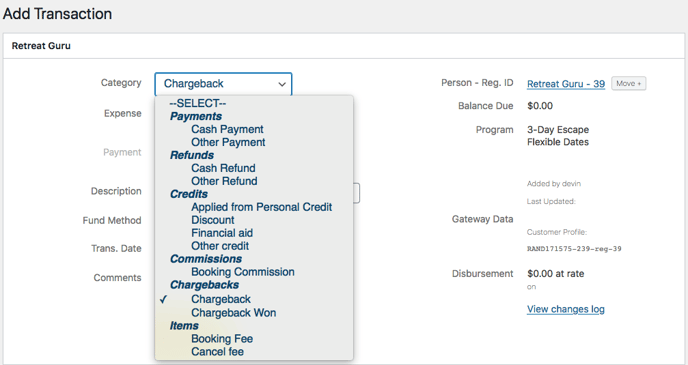
The value for a chargeback transaction is an expense or deduction.
Enter in the chargeback amount, the description, fund method, and comments (store all your chargeback information, in this section for your records). Then click Save Transaction.
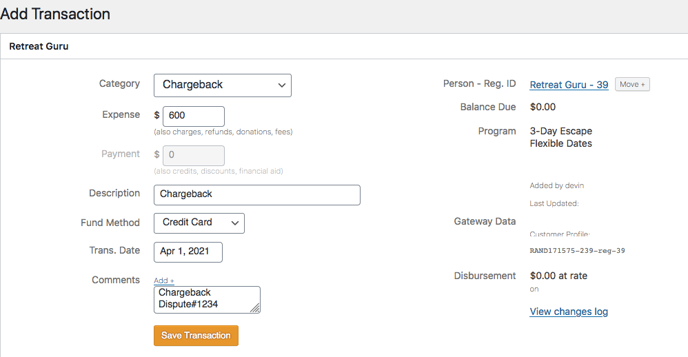
This transaction will appear on the registration as a Chargeback (open). If you need to access the comments for stored chargeback information click on the link, Chargeback (open), to view or add more information for this transaction.

Chargeback Won Transaction
If a chargeback is won by your center you may see an additional transaction on the registration. This transaction category is a charge to a guest's bill. This category should only be used when a chargeback has already been applied to a registration.

To manually add a chargeback won transaction to a registration, open a registration and choose an option to add a payment.
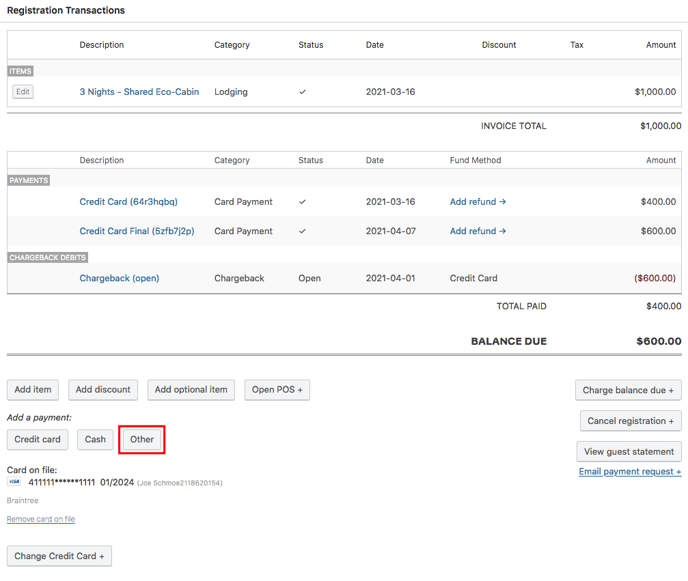
Choose Chargeback Won from the transaction category drop-down menu.
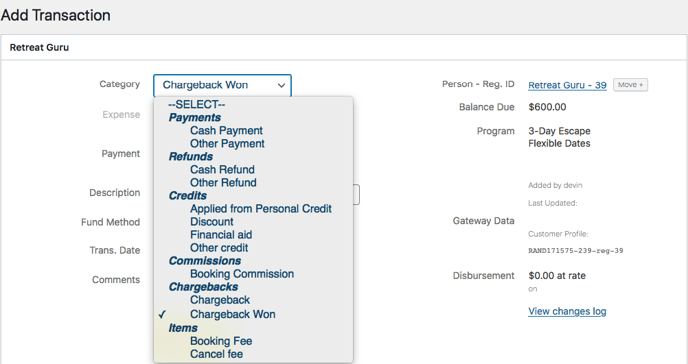
The value for a Chargeback Won transaction is a charge to a guest.
Enter in the chargeback won amount, the description, fund method, and comments(you can include the information from the original chargeback or note the transaction ID of the original chargeback here). Then click Save Transaction.
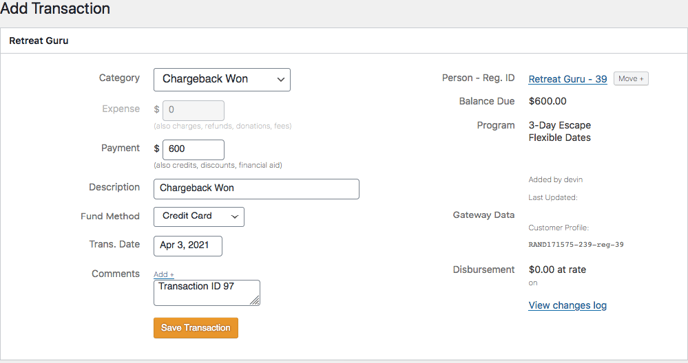
This transaction will appear on the registration as a Chargeback Won.
Reports
You can filter your transaction report to see any instance that one or both of these categories have been applied.
Navigate from the Admin Side Panel > Transactions > Filters and Reports + > Select Trans. Category > Apply Filter.
